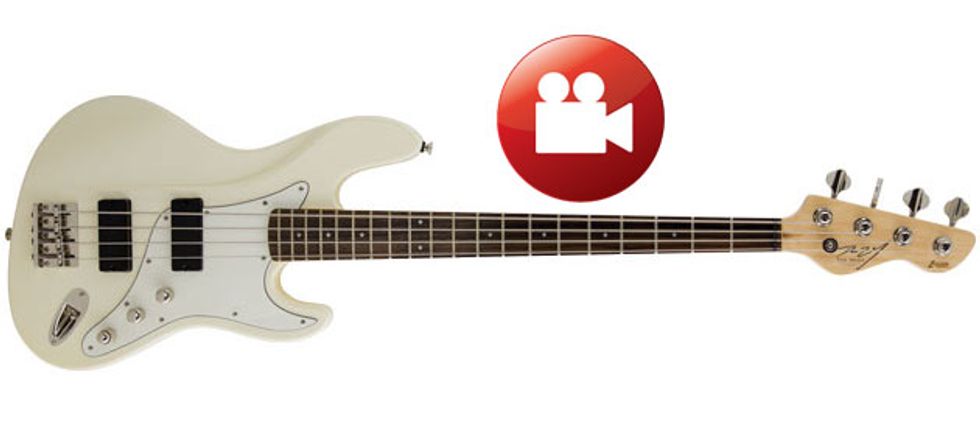
Dean Zelinsky’s impact on guitar design is undisputed. He’s created instruments for rock royalty, from Dimebag Darrell’s ML guitar to the outrageous fur axes spun by Billy Gibbons and Dusty Hill. Now the founder of Dean Guitars has a new venture: Dean Zelinsky Guitars. The line includes the Mule, a unique new take on J-style designs.
Mule School
Like its equine namesake, the Mule 4-string is a hybrid. It melds traditional J-style construction with Zelinsky innovations. Our test model’s vintage white finish gives the basswood body a pleasingly classic look. (The Mule is also available in classic black, transparent amber, and burst finishes.) A rosewood fretboard caps the bolt-on maple neck. (Maple fretboards are also available.) The Mule also comes in a 5-string version.
Zelinsky tweaked tradition by shaping the neck with a medium-thin, soft “C” shape, but he preserves the past with a 12" fretboard radius.Meanwhile, his open-gear tuners give a classic look a contemporary twist while offering pinpoint accuracy. The Mule is devoid of 60-cycle hum thanks to a pair of DZPLG active humbuckers. A 9V battery powers both the pickups and a preamp with 2-band EQ.
Two striking enhancements make the Mule stand out from the herd: Zelinsky contours the upper body with what he calls a “Thumb-Rail” design. (Many bassists who regularly shift their plucking-hand position for varied tones will appreciate this supportive thumb rest across most of the body’s length.) But the pièce de résistance resides on the bass’s rear side: the patented Z-Glide reduced-friction neck. The engraved pattern of the Z-Glide reduces the surface area by 70 percent, allowing air to pass under the thumb. This helps keep the fretting hand dry and alleviates the sticky feel of some glossy and satin-finished necks. (For a slight upcharge, players can request a personalized Z-Glide neck with their name engraved.)
Take A Walk On Z-Glide Side
I experienced a touch of neck dive with the bass strapped while standing. My balance concerns were even more pronounced while sitting down with the bass’s body on my thigh. But positioning the bass between my legs, classical guitar-style, let me explore the neck without any balance issues.
For someone who’s spent decades playing on both finished and unfinished necks, shifting up and down the Z-Glide neck was a new sensation. The engraved pattern definitely kept my thumb dry and prevented any stickiness whatsoever. That said, it took some time to get comfortable with the texture—it is a totally different feeling. I’m by no means a “monkey grip” player, but I had to adjust my thumb pressure to accommodate the design.
Ratings
Pros:
A unique twist on the J-bass formula. Solid electronics. Affordable.
Cons:
Design innovations not for everyone. Balance issues.
Tones:
Playability:
Build/Design:
Value:
Street:
$649
Dean Zelinsky Guitars Mule Bass
deanzelinsky.com
I dig the look of the thumb-rail design, which may be a great benefit for players who tend to rest a thumb on the body. It doesn’t necessarily cater to my right-hand damping technique, since anchoring the thumb above the strings make unwanted vibrations more prominent. Still, the design provides a pleasant arm contour that lets players who use a pick or floating-thumb technique maintain a relaxed plucking-hand position.
Big Bottom, Punchy Mids
The Mule’s tones combine past influences with modern timbres. Balancing both pickups produces a sound with strong lows, slight low-mid punch, and bright top end. Soloing the neck pickup conveys a deeper tone that suggests a cross between a G&L L-2000 and a Modulus Quantum. The bridge pickup alone has the expected bark, but with that extra thickness typical of a humbucker.
The Mule provided a consistent, supportive foundation on a blues gig. Plugged into an Epifani UL 501 paired with an Ampeg 4x10, the bass provided enough bottom to punch through the quintet with authority while the crystalline top end effortlessly cut through the mix. Working the neck pickup, I created full, sustained notes ideal for ballads and Motown classics. Mixing the pickups and boosting both lows and highs provided a slap tone with tight lows and piercing, popping transients, perfect for R&B tunes and modern gospel songs. For a 16th-note funk jam, I dialed the blend back toward the bridge pickup. At first it didn’t deliver the thick yet biting tone I’d heard at home, but a simple bass boost provided sufficient beefiness. By the end of the night, I considered Zelinsky’s preamp an effective onstage problem solver.
The Verdict
The Mule has a big voice thanks to new construction approaches. Bassists who like bright, beefy, slightly scooped sounds will probably enjoy what it has to offer. The Z-Glide neck might not be for everyone, but sweaty-handed players may appreciate its benefits. With a price nowhere near budget-buster territory, the Mule could be a dependable companion to carry your low-end load.
Watch the Review Demo:







![Rig Rundown: AFI [2025]](https://www.premierguitar.com/media-library/youtube.jpg?id=62064741&width=1245&height=700&quality=70&coordinates=0%2C0%2C0%2C0)












 Shop Scott's Rig
Shop Scott's Rig

![Rig Rundown: Russian Circles’ Mike Sullivan [2025]](https://www.premierguitar.com/media-library/youtube.jpg?id=62303631&width=1245&height=700&quality=70&coordinates=0%2C0%2C0%2C0)













































